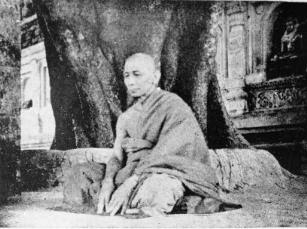 The existence of the Global Pagoda in Mumbai, and all beings benefiting from Vipassana owe an infinite debt of gratitude to Venerable Webu Sayadaw (1896-1977), the respected monk teacher of Burma. Webu Sayadaw was the first to strongly exhort Sayagyi U Ba Khin to teach Vipassana, in July 1941, an instruction that U Ba Khin immediately followed.
The existence of the Global Pagoda in Mumbai, and all beings benefiting from Vipassana owe an infinite debt of gratitude to Venerable Webu Sayadaw (1896-1977), the respected monk teacher of Burma. Webu Sayadaw was the first to strongly exhort Sayagyi U Ba Khin to teach Vipassana, in July 1941, an instruction that U Ba Khin immediately followed.Soon, the happy, liberating light of Dhamma began glowing worldwide after Sayagyi U Ba Khin's devoted student Sayagyi U S.N.Goenka started teaching Vipassana in Mumbai, India from 1969.
To gain real benefits of Dhamma, Webu Sayadaw stressed much on Viriya, or Right Effort of proper, continuous, untiring practice, and to get rid of laziness and wasting time. He taught Anapana meditation - objectively observing the natural in-coming, out-going breath. Anapana is the preliminary practice to develop Samma Samadhi, or right concentration, needed for Vipassana.

The Vipassana surgery of the mind progressively removes all deep-rooted defilements. The pure mind experiences true happiness and becomes base for practice of Metta Bhavana (the third part of Vipassana), to share the benefits thereby gained, with all beings.
Below is one of Venerable Webu Sayadaw's well-known discourses, "To light a fire", translated from Burmese (by R.Bischoff).
Venerable Webu Sayadaw: You have taken the moral precepts, now practice them. Only when your practice of morality (sila) is perfect can you fulfill your aspirations for awakening. Having perfected yourselves in morality, you have to perform various other meritorious practices, and these can take you to the pinnacle and the fulfillment of your aspirations.
The teachings of the Buddha are enshrined in the Tipitaka. These teachings were not given by the Buddha just to be preached and studied. You are good people; you have to practice the teachings with unwavering effort from the time you obtain them in order to escape from this suffering.
Do not get confused about the teachings. We don't have to know many techniques, only one; but that we should know clearly. If we establish one technique with strong effort and get rid of all doubts then, without asking anyone else, we shall find the answers.
Choose one technique and practice it.
(In Anapana) if you focus your mind at the small spot where the air touches when you breathe in and out, then there will be no wanting, no aversion or delusion, and as these three are absent, you are immediately out of suffering.
So, for a short moment Your mind is pure. Now, if your last mind-moment came up at this time and you died, would there be anything to be worried about or to be afraid of?
The benefits accruing to you from this practice don't last for just a short moment or one life-time. This short moment of purity will bring benefits for the remainder of the cycle of birth and death. And why can you accomplish this? Because the time is right, your form of existence is right, and you are putting forth right effort.
Students of the Buddha took the practice from the Teacher and worked with unwavering perseverance. Therefore, they achieved the awakening they had aspired for.
How did they work? In the same way as a man who wants to light a fire with a fire stick, as in the olden days. They rubbed two pieces of wood together, and heat was produced. Eventually the wood started to glow, and then they could light a fire. So, if a man wants to start a fire in this way, and rubs two pieces of wood together, does he count: "One rub, two rubs, three rubs..."?
Meditator: No, sir, that wouldn't work very well.
Sayadaw: How would he have to do it then?
M: He would have to rub continuously until he got a flame.
S: Yes, when they wanted to start a fire in those days, this was the only way to do it. They had to rub with strong determination and without taking breaks. Now, if one were to rub two pieces of wood together in this way, how long would it take for the fire to start?
M: When it gets hot enough, the fire will start, sir.
S: Will that take long?
M: Not very long, sir.
S: No, if this man works with determination, it doesn't take long. It is just the same with this practice here. You want fire. You know that if you rub these two pieces of wood together you can have it. Now, if you count, "One rub, two rubs..." it will become a little bit hot. And then you take a rest for a while. Will you start a fire?
M: No, sir.
S: OK, so you start again, once, twice, three times... and again heat is produced. Then you lay back again and take a bit of rest. Will you start a fire?
M: No, sir. .
S: And if you continue in this way for a whole month?
M: We won't get fire.
S: And if you continue for a whole year?
M: It will just get warm, sir, but there will be no fire.
S: Now, what if you were to work like this for one hundred years?
M: It will just become warm, sir.
S: In that case, there is no fire in these two pieces of wood?
M: There is fire, sir, but effort and perseverance are not sufficient.
S: It is just the same with our work. You have to work as the fire maker does, without taking rest. Soon, before long, a fire will start. Only then will you be able to use the fire in the way you want. You should all make the right effort to fulfill your aspiration for awakening.
--
Viriya, The Pāramī of Proper Efforts
Sayagyi U Ba Khin's meeting with Webu Sayadaw, July, 1941
* Vipassana meditation courses worldwide, course venues, online application for Vipassana courses
* Directions to reach Global Pagoda, Gorai / Borivili, Mumbai
* Dhamma service opportunities at Global Pagoda
* Earning boundless merits through Dhamma dana for Global Pagoda
